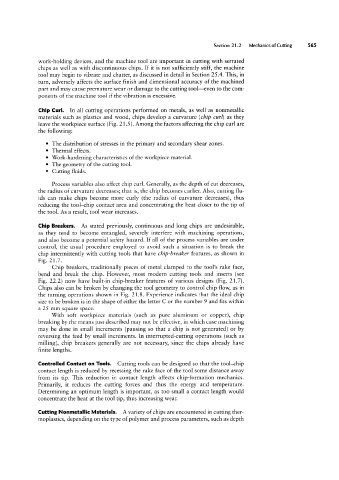Page 584 - 04. Subyek Engineering Materials - Manufacturing, Engineering and Technology SI 6th Edition - Serope Kalpakjian, Stephen Schmid (2009)
P. 584
Section 21.2 Mechanics of Cutting
work-holding devices, and the machine tool are important in cutting with serrated
chips as well as with discontinuous chips. If it is not sufficiently stiff, the machine
tool may begin to vibrate and chatter, as discussed in detail in Section 25.4. This, in
turn, adversely affects the surface finish and dimensional accuracy of the machined
part and may cause premature wear or damage to the cutting tool-even to the com-
ponents of the machine tool if the vibration is excessive.
Chip Curl. In all cutting operations performed on metals, as well as nonmetallic
materials such as plastics and wood, chips develop a curvature (chip curl) as they
leave the workpiece surface (Fig. 21.5 ). Among the factors affecting the chip curl are
the following:
° The distribution of stresses in the primary and secondary shear zones.
° Thermal effects.
° \Y/ork~hardening characteristics of the workpiece material.
° The geometry of the cutting tool.
° Cutting fluids.
Process variables also affect chip curl. Generally, as the depth of cut decreases,
the radius of curvature decreases; that is, the chip becomes curlier. Also, cutting flu-
ids can make chips become more curly (the radius of curvature decreases), thus
reducing the tool-chip contact area and concentrating the heat closer to the tip of
the tool. As a result, tool wear increases.
Chip Breakers. As stated previously, continuous and long chips are undesirable,
as they tend to become entangled, severely interfere with machining operations,
and also become a potential safety hazard. If all of the process variables are under
control, the usual procedure employed to avoid such a situation is to break the
chip intermittently with cutting tools that have chip-breaker features, as shown in
Pig. 21.7.
Chip breakers, traditionally pieces of metal clamped to the tool’s rake face,
bend and break the chip. However, most modern cutting tools and inserts (see
Fig. 22.2) now have built-in chip-breaker features of various designs (Fig. 21.7).
Chips also can be broken by changing the tool geometry to control chip flow, as in
the turning operations shown in Fig. 21.8. Experience indicates that the ideal chip
size to be broken is in the shape of either the letter C or the number 9 and fits within
a 25-mm square space.
With soft workpiece materials (such as pure aluminum or copper), chip
breaking by the means just described may not be effective, in which case machining
may be done in small increments (pausing so that a chip is not generated) or by
reversing the feed by small increments. In interrupted-cutting operations (such as
milling), chip breakers generally are not necessary, since the chips already have
finite lengths.
Controlled Contact on Tools. Cutting tools can be designed so that the tool-chip
contact length is reduced by recessing the rake face of the tool some distance away
from its tip. This reduction in contact length affects chip-formation mechanics.
Primarily, it reduces the cutting forces and thus the energy and temperature.
Determining an optimum length is important, as too small a contact length would
concentrate the heat at the tool tip, thus increasing wear.
Cutting Nonmetallic Materials. A variety of chips are encountered in cutting ther-
moplastics, depending on the type of polymer and process parameters, such as depth

